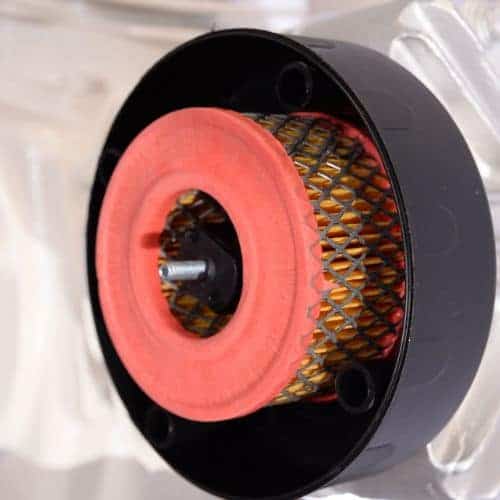How to Clean Air Compressor Tank? 6 Easy Steps
TheToolGeeks.com is a participant in the Amazon Services LLC Associates Program and other affiliate advertising programs. We may earn from qualifying purchases. (Learn More).
When an air compressor works, it uses the air from the surrounding environment, in which there can be particles of dirt. The dirt gets into the steam and then into the tank of the air compressor. If not cleaned regularly, it can damage it. But how to clean air compressor tank?
It is crucial to turn off the air compressor when cleaning the air compressor tank. Drain the reservoir thoroughly as well. As we continue in this article, we will discuss the other steps of cleaning the inside of the air compressor tank. We will also discuss the reasons why it gets dirty.
Jump To Page Contents:

How Would I Know If my Air Compressor Needs Cleaning?
Usually, you should drain and monitor the compressor daily or after every use for proper cleaning. But sometimes, you may not get time to clean it, or you may leave it with moisture inside, which will cause rusting.
Rust Getting out of your Lines
If you’re doing your job with an air compressor and getting rust from the lines, It’s time to clean your air compressor for good. Well, sometimes it’s a negligible amount of rust, but when you keep noticing rust or other particles from the lines, You should now clean it!
We’re just highlighting the symptoms of an uncleaned air compressor tank; we will give you prevention tips shortly.
Pressure is Less than the Usual
When the compressor stops working or works at a low speed, it has cleaning issues. A load of dirt on the component of the compressor leads to a reduction in the pressure of the tank.
Sometimes, the Sound of the Air Compressor Changes
When the compressor is not clean and needs cleaning, the pressure starts to double on the compressor’s components. The burden on the motor or filters and fan causes more noise. Clean the dust!
Why Cleaning and Air Compressor is Necessary?
By regularly cleaning your air compressor tank, you can keep it in good working condition for an extended time. It will help extend its life and reduce the possibility of future troubleshooting problems related to how to clean an air compressor.
We recommend you drain out your air compressor tank daily or every time you use it.
How to Clean Air Compressor Tank? 6 Steps Guide
Pressure builds and compresses the air inside your air compressor reservoir. The water vapor also becomes compressed, and it causes water to accumulate and sometimes rust the walls of tanks. One solution to this problem involves draining and cleaning the reservoir of the compressor. Please do this draining of the tank daily when using the machine to safeguard the air compressor tank.
Many industries use air compressors as a part of their everyday lives. Cleaning the air compressor’s tank is necessary to ensure its proper functioning. There are 6 steps that you need to follow when cleaning the inside of an air compressor tank.
1. Check for Oil & Air Leakage
Make sure there are no oil leaks or air leaks. There could be a leak. If there is any, make sure to fix it.
There is no way to see air leakage; you will need to hear the sounds to check. You should find and repair leaks before turning them on. Make sure you take care of them after repairing them. Do not start it until you fix the leaks.
2. Turn Off Air Compressor
Before you begin cleaning, ensure that the air compressor is not working. It will ensure that you will not cause any accidents. You will not harm yourself or damage the air compressor.
3. Release Compressed Air
Make sure to release all the compressed air from the compressor tank before starting to clean. While you are cleaning inside the compressor tank, it will ensure no sudden air pressure release. In addition, it will prevent accidents or injuries.
4. Open the Drain Valve
You should open the drain valve now since the air compressor isn’t working. There is a ring on the side of the tank. Grab it and slowly open it. Do this until it is entirely open.
5. Empty the Compressor with the Drain Valve
After opening the drain valve, empty the entire tank via the drain valve. The tank can contain oil and sludge. Keep the drain open for a few hours so the tank will dry out, and these can come out of it during air release.
6. Close the Drain Valve Tightly
Your Compressed air tank is drained out completely and is properly cleaned. It’s time to close the drain valve tightly, and you may use your air compressor now.
How do I get rust out of my air compressor tank?
Muriatic acid is one of the only safe ways to remove rust, but it may damage your compressor tank if you use it too much.
You can remove rust using a safe and effective method. It involves the use of phosphoric acid, which won’t damage your tank, and you can get rid of the rust with ease.
Air Compressor Check Valve Cleaning
Yes, cleaning the compressor’s check valves is essential to make it stay longer. First, unscrew the check valve with wrenches. Then use a cloth (Apply alcohol) to clean the check valve from the inside.
Keep in mind not to disturb the ball and its connections!
What are the Causes of Dirty Air Compressor Tanks?
Let’s see some of the causes why an air compressor tank becomes dirty.
- Using the air compressor for a long time without letting it dry is the most likely to cause the tank to rust.
- If your equipment has been used in moist or wet conditions and has not dried completely, it may suffer from corrosion. It can occur by water-oil mixtures building up inside the air compressor tank.
What If I Don’t Clean My Air Compressor? What Will happen?
By cleaning your air compressor tank regularly, you can keep it in good working condition for an extended time. It will help extend its life and reduce the possibility of future troubleshooting problems related to how to clean an air compressor.
We recommend that you drain out your air compressor tank daily or every time you use it. Also, if you do not clean your air compressor these things may happen sooner or later…
- Long time, no cleaning can cause corrosion, leading to an explosion of the tank over time.
- No cleaning shortens the lifespan of the compressor.
- There will be damaged pumps and leaks in the tank, which is dangerous.
- No cleaning and no monitoring will also affect the tools attached to it.
Air Compressor Maintenence Tips
- The nuts and bolts should be perfect. ( they should not be loose or extra tight)
- It would help if you cleaned the intake valves
- Always check the hoses and pumps before and after every use.
- Ensure to Check and clean the filters of the compressor
- Drain the tank and let it dry after every use ( no moisture)
- Always clean the fuel tank.
- The oil of the compressor should be changed
- Change or clean the oil/air separators
What is the lifespan of an air compressor Tank?
With proper care and monitoring. You can last your air compressor tank for 8-10 years, and the compressor’s tank can easily remain for 10-15 years if you drain the tank and then dry it after every use.
Air Compressor Filter Spring Cleaning
An air compressor requires its air filter element to be reviewed for every seasonal examination. The longer you wait until your engine runs out you will reduce your air compressor’s effectiveness.
Properly functioning filters can save you money each year. These filters are generally standard and easy to check, though the exact process of an air compressor’s filters could differ somewhat from one manufacturer to another. Remember always take your time and consult your manual if there’s a part or step you’re not familiar with.

Changing your Pump Oil
You can replace the oil in your air compressor when completing spring maintenance. Keep your compressor operating smoothly and efficiently with a fresh batch of oil, eliminating and replacing your oil cylinder.
Conclusion
Mostly, industries and factories use air compressors. They are an integral part of their lives. Probably you have air compressors at home or your workplace. One of the most important things you have to do is clean the tanks regularly. Do you know how to clean an air compressor tank?
To clean the compressor tank, you will need to release the air that is present in it. Also, make sure you turn the compressor off. Check for leaks and open the drain valves, then leave them open until you clean the tank from the inside, but close them tightly after it has dried.
If you are not cleaning the tank and using it like this, it will lead to dirt in the air compressor tank. Furthermore, we have discussed in this article the importance of cleaning the tank and the steps to get rid of rust. Make sure to read it for a better understanding of the cleaning of the tank.
FAQs
How to Dry out Air Compressor Tank?
After draining, you can dry the compressor tank using a cloth. Use a dry clot and dry the inside of the tank. You can also let it remain open and dry over time. You can also use a dryer to dry the inside of the tank.
Is it ok to Put Oil in an Air Compressor Tank?
Yes. It is always advisable to fill air compressor tanks with Oil, and the purpose of oil in an air compressor tank is to lubricate the moving parts of your equipment and prevent corrosion.
Are air compressor tanks coated inside?
Yes, the compressor tanks have a coating inside the tank to secure it. Over time the coating may ge damaged and start to get damaged. To secure your tank: drain the tank, monitor it, and dry it after every use. This will secure the tank from corrosion!
Amazon and the Amazon logo are trademarks of Amazon.com, Inc, or its affiliates.
